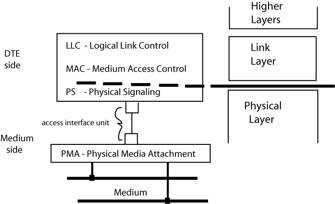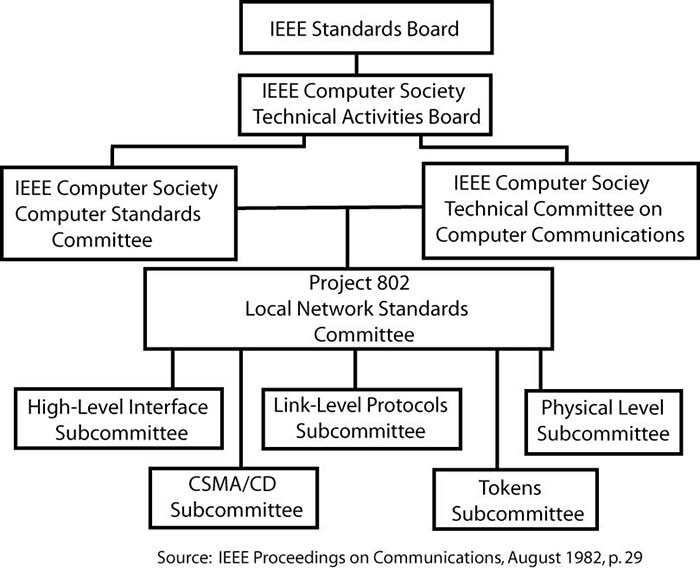Chapter 11 - Standards: An Enabling Institution 1979-1984
11.4 IEEE Committee 802 and DIX: 1980 - 1981
At the May IEEE Committee 802 meeting, DIX supplemented the press release with a two-page description of Ethernet with the message:
This is a reasonable approach to creating a local area network and if the committee wants to consider it, we’d be willing to work with them. If they don’t want to consider it, we’re going to do it anyway, but we’d still be willing to participate.6
Opposition immediately decried DIX’s heavy-handed tactics of undermining the goal of standards-making independent of corporate influence. DIX also received public support, such as from Greg Hopkins, chairman of IFIP, which like the IEEE had created a working group or committee to develop a LAN standard. Quoted in Data Communications in June 1980, Hopkins opined:
This is a significant announcement because of the sheer size of the companies involved and is a step toward the integrated office of the future.7
Graube did not welcome DIX’s actions. If Ethernet became a de facto standard outside the IEEE 802 process, it might undermine the authority and legitimacy of Committee 802 to create a successful standard. As much as he frowned on DIX-type efforts, neither did he want DIX to act independently of Committee 802. From that same Data Communications article of June 1980, Graube urged cooperation:
Other companies may have other opinions, and Xerox may not be able to satisfy everyone’s needs………..The U.S. is no longer alone as the technological leader, so we will have to comply with international standards – just because the U.S. has a de facto standard does not mean that it will be accepted overseas.8
Against this swirling background intrigue, the agenda of the May meeting to organize a committee structure to begin standardization efforts resulted in three subcommittees: the Physical Level, Link Level and High-Level Interface subcommittees. Substituting layer for level, they conform to the following diagram. (See Exhibit 9.3 IEEE LAN Architecture.9
Exhibit 11.4.1 IEEE LAN Architecture

The Physical Level subcommittee chaired by Jerry Clancy (of Honeywell) intended to create the functional specifications for the physical media and how to signal over it.
The Link Level subcommittee chaired by Nathan Tobol (Codex)10 would define the protocol imposed on the Physical Level signals – whether polled or token passing for example.
More open-ended was the High-Level Interface subcommittee chaired by Allen Rochkind (Spectra Physics). Graube remembers:
I thought there would be a group that would look into the interfacing issues. At that time, interface to me meant a hardware interface – how does a chip, a semiconductor part, interact with a microprocessor. That’s the interface I thought about. As it turned out, it’s more of a logical interface than a hardware one, and we have very little to say about how the microprocessors work.
Graube recalls the hectic pace to become a hallmark of Committee 802:
We basically started out with great enthusiasm. There were many meetings held. I think we held a meeting every two months or so, and they grew very quickly from three-day meetings to full-week meetings, and a lot of times we’d start on Sunday and work all through the week.
After the June Physical Level subcommittee meeting, held in tandem with a PROWAY meeting, many PROWAY members switched the focus of their efforts to IEEE 802. In another effort to speed committee work, a further subcommittee, the Media Access Group, was formed and scheduled a meeting for September.
At the September meeting of the Media Access Group, held at Gould-Modicom in North Andover, MA, the discussions turned decidedly more technical. So far, those attending Committee 802 meetings had been shadow boxing with four camps of technological interest. The first camp was, DIX and its Ethernet, or CSMA/CD, technology. The second camp consisted of the much more loosely organized PROWAY advocates who favored a token technology of some kind. The computer giant IBM constituted the third camp, rumored to favor token ring, but unwilling to make clear their intentions! Their dominant market position seemingly gave them the opportunity to set a de facto standard. IBM’s indecision invaded every conversation like a black cloud. Could Committee 802 act without IBM revealing its LAN? The fourth, the chaotic camp, grew weekly as firms announced proprietary LAN solutions of every kind. Graube’s goal of one standard grew doubtful?
Adding pith to the September meeting, Mike Kryskow, of Gould-Modicom, presented a paper on a token bus protocol he had created. The contrast between a deterministic token network and the probabilistic CSMA/CD caused many to question whether CSMA/CD could be the standard. A token standard gained momentum.
On September 30, DIX released their Ethernet specification as promised. Known as the “Blue Book” by the color of its cover, Kaufman remembers:
Some 25,000 copies were printed on my INTEL budget and passed out to the world. What we tried to say was: ‘Here it is. We’ve signed up for it. We’re going to make this work, and if you want to put a standards stamp on it, that’s fine.’ Of course, we didn’t really take into account the fact that there were lots of other people in the world with other axes to grind that would try to perturb the standard, and in hindsight, maybe we should have just held it quiet for another couple of years until we were delivering, but we took it to the IEEE and a lot of people spent a lot of money fighting Ethernet.
Liddle characterizes the waiting committee of skeptical engineers as:
The howling mob at the IEEE.
In an October announcement meant to stem the token tide, HP endorsed, and pledged active support, for a CSMA/CD standard. (An action seeded in the monthly meetings between Kaufman and Crockett.) Don Loughry of HP reflects on the tension:
In the May meeting in Washington D.C. [NBS], DEC, Intel and Xerox presented their Ethernet solution. They made a strategic blunder. They basically said: ‘We have THE answer.’ But it backfired. They didn’t understand what they had to do to sell something, that you just don’t present a solution and expect one hundred other companies to say: ‘Rah,’ especially the likes of the large companies involved. So then the dust began to settle a little bit, and on September 30th Ethernet Rev. 1 was produced. By that time, there was a real need to begin to put this thing together in an orderly fashion.
The next meeting in Phoenix in December loomed like a championship prize-fight. If there was to be one standard, a choice between CSMA/CD and token passing seemed imperative.
Chairman Graube recalls:
It was becoming clear to me that things were not going to converge into anything.11
Loughry of HP, who would play an important role during and after the meeting, remembers:
So, at this December meeting, this was known and kind of forecast by those that were on the inside, to be a real shoot-out, because this was the time that they were going to sink CSMA/CD and it was going to be buried, and some rather large companies were determined to make that happen. I was sort of elected, or promoted, or whatever – nominated – by the likes of Metcalfe and John Schoch, to be the cheerleader and the spokesperson for CSMA/CD.
Kaufman of Intel remembers the attitude of the DIX members, especially Intel:
Our strategy fundamentally was ‘they’re not going to kill Ethernet, and if IEEE kills Ethernet, we don’t care because there’s nothing else at this point.’ IBM was talking about token ring, but had no spec, and if they did have a spec, they wouldn’t release it, and the people they sent clearly didn’t speak for IBM and kept saying they wouldn’t speak for IBM. So what the IEEE was talking about in terms of token was a non sequitur to us. We were going to ship CSMA/CD no matter what, and we were going to follow the IEEE, and if they settled on something, we’d ship it that way. If they didn’t settle on something by the time the chip was ready, we’d ship the chip, and that’s why we were calling it the ‘Eithernet’ chip, because of all the variations that were coming along in CSMA/CD, not because we were going to make a token ring part of it. Nobody knew how to make one of those.
At the meeting a combination of the PROWAY and IBM proponents aligned in favor of token technology as the basis of the future Committee 802 LAN standard. In the vote to endorse tokenism, the ayes failed to achieve the required three-quarters majority.12 It was equally apparent, however, that neither could CSMA/CD – Ethernet – attract a three-quarters majority. Seemingly at an impasse, Committee 802 crafted a compromise: two standards would be created. The choice avoided failure, even disbanding. Two new subcommittees, CSMA/CD and token passing, appended the existing three subcommittee structure. Loughery became chairman of the CSMA/CD subcommittee.13 (See Exhibit 9.4 Committee 802 Subcommittee Structure.[14])To maintain some semblance of one standard, the Committee required all specifications other than the access algorithms to be identical and all members continued to vote on both standards; rules seeding future conflict.15
Rosenthal, an informed user, felt betrayed:
My view was that this was a real disaster. Here I was trying to make standards for use in the government, and now I’ve got to choose between two technologies. I was furious, but I had to live with that. So I turned my attention to the CSMA/CD arena because of all of the stuff I knew about CSMA/CD. I knew it very, very well, and I had a network.
In January 1981, the editorial headline in Data Communications magazine’s Viewpoint read: “IEEE decision places a roadblock in local networking’s path.”16 The scathing editorial ended with:
The IEEE should reconvene its local network standards committee as soon as possible and should face up to the challenge of the industry by deciding on a meaningful standard for local-network access.
Graube in an article in the same issue of Data Communications labeled the Committee 802 decision as: “sort of a cop out.”
Exhibit 9.4 IEEE Committee 802 Subcommittee Structure
Exhibit 11.4.2 IEEE Committee 802 Subcommittee Structure

LAN technologies and economics had complicated the plans of Committee 802. What fate faced the OSI standards being developed by ISO?
- [6]:
Marvin Sirbu and Kent Hughes, Standardization of Local Area Networks, Department of Engineering and Public Policy, Carnegie Mellon University, April 1986, p. 11
- [7]:
Data Communications, June 80, p. 26
- [8]:
Ibid.
- [9]:
IEEE Standards manuals or Computerworld, Nov. 5, 1984
- [10]:
Proving Codex participated early in LAN market formation.
- [11]:
“Newsmakers: Maris Graube,” Data Communications, Dec. 1980, pp.51-52
- [12]:
Rosenthal: “The meeting was packed full of IBM’ers, it was packed full of everybody who had a stake. Then the PROWAY people were there, the old time process control community that didn’t want anything to do with token ring. They loved the bus technology, but they couldn’t deal with the probabilistic nature of CSMA/CD. They had to be deterministic, so they had a token mindset, but it wasn’t token ring, it was token bus. So you had two important camps, the token camp versus the CSMA/CD camp. The vote was taken.”
- [13]:
Loughery had prior standards experience with X3 -T9 (488 instrumentation standard)
- [14]:
Ware Myers, “Toward a Local Network Standard,” IEEE Micro, Aug. 1982, p.2
- [15]:
Marvin Sirbu and Kent Hughes, Standardization of Local Area Networks, Department of Engineering and Public Policy, Carnegie Mellon University, April 1986, p. 3
- [16]:
“Viewpoint,” Data Communications, Jan. 1981, p.9